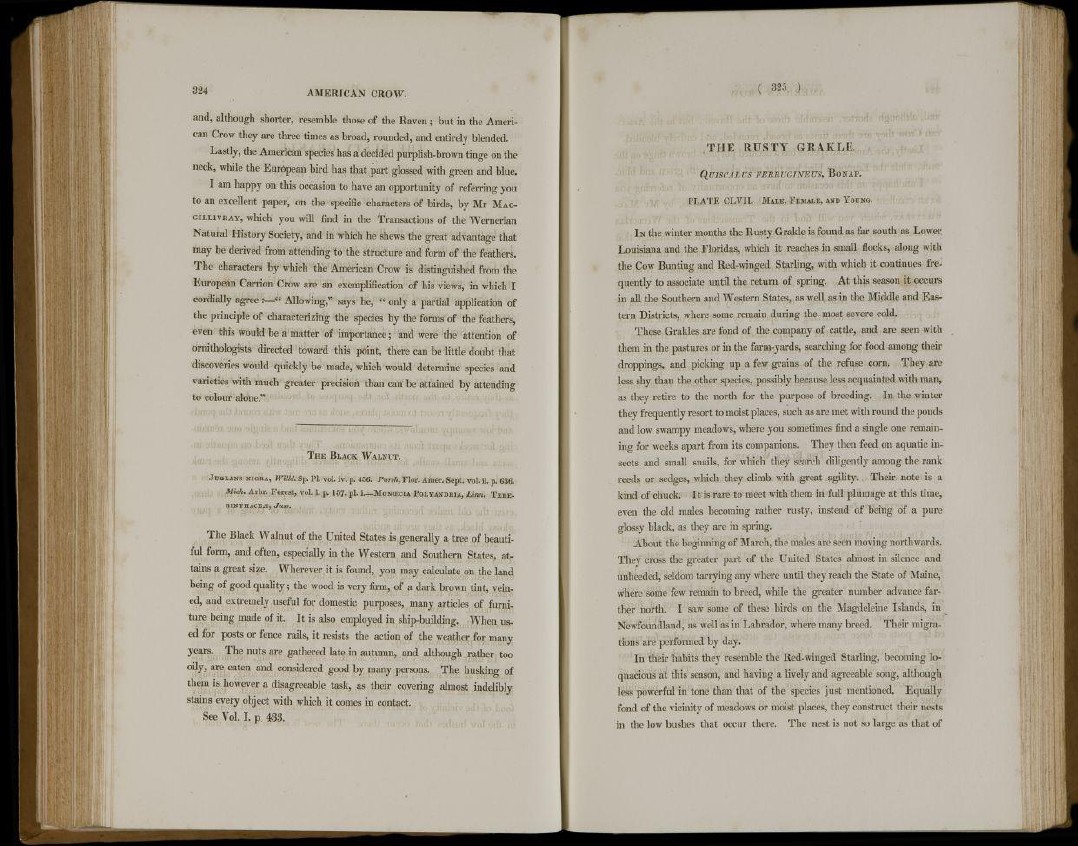
324 A M E R I C A N CROW.
and, although shorter, resemble those of the Raven; but in the American
Crow they are three times as broad, rounded, and entirely blended.
Lastly, the American species has a decided purplish-brown tinge on the
neck, while the Eur6pean bird has that part glossed with green and blue.
I am happy on this occasion to have an opportunity of referring you
to an excellent paper, on the specific characters of birds, by Mr MACGILLIVKAY,
which you will find in the Transactions of the Wernerian
Natural History Society, and in which he shews the great advantage that
may be derived from attending to the structure and form of the feathers.
The characters by which the American Crow is distinguished from the
European Carrion Crow are an exemplification of his views, in which I
cordially agree :—" Allowing," says he, " only a partial application of
the principle of characterizing the species by the forms of the feathers,
even this would be a matter of importance; and were the attention of
ornithologists directed toward this point, there can be little doubt that
discoveries would quickly be made, which would determine species and
varieties with much greater precision than can be attained by attending
to colour alone.1'
THE BLACK WALNUT.
JUQLANS NIGRA, Willd. Sp. PI. vol. iv. p. 456. Pursh, Flor. Amer. Sept. vol. ii. p. 636.
Mich. Arbr. Forest, vol. i. p. 157. pi- i—MONUTXIA POLYANDRIA, Linn. TEREIII
N'TII AC IO.I:. Juss.
The Black Walnut of the United States is generally a tree of beautiful
form, and often, especially in the Western and Southern States, attains
a great size. Wherever it is found, you may calculate on the land
being of good quality; the wood is very firm, of a dark brown tint, veined,
and extremely useful for domestic purposes, many articles of furniture
being made of it. It is also employed in ship-building. When used
for posts or fence rails, it resists the action of the weather for many
years. The nuts are gathered late in autumn, and although rather too
oily, are eaten and considered good by many persons. The husking of
them is however a disagreeable task, as their covering almost indelibly
stains every object with which it comes in contact.
See Vol. I. p 433.
( 325 )
T H E RUSTY GRAKLE.
ClUISCALUS FERRUGINEUS, BoNAP.
P L A T E C L V I I . MALE, FEMALE, AND YOUNG.
IN the winter months the Rusty Grakle is found as far south as Lower
Louisiana and the Floridas, which it reaches in small flocks, along with
the Cow Bunting and Red-winged Starling, with which it continues frequently
to associate until the return of spring. At this season it occurs
in all the Southern and Western States, as well as in the Middle and Eastern
Districts, where some remain during the most severe cold.
These Grakles are fond of the company of cattle, and are seen with
them in the pastures or in the farm-yards, searching for food among their
droppings, and picking up a few grains of the refuse corn. They are
less shy than the other species, possibly because less acquainted with man,
as they retire to the north for the purpose of breeding. In the winter
they frequently resort to moist places, such as are met with round the ponds
and low swampy meadows, where you sometimes find a single one remaining
for weeks apart from its companions. They then feed on aquatic insects
and small snails, for winch they search diligently among the rank
reeds or sedges, which they climb with great agility. Their note is a
kind of chuck. It is rare to meet with them in full plumage at this time,
even the old males becoming rather rusty, instead of being of a pure
glossy black, as they are in spring.
About the beginning of March, the males are seen moving northwards.
They cross the greater part of the United States almost in silence and
unheeded, seldom tarrying any where until they reach the State of Maine,
where .some few remain to breed, while the greater number advance farther
north. I saw some of these birds on the Magdeleine Islands, in
Newfoundland, as well as in Labrador, where many breed. Their migrations
are performed by day.
In their habits they resemble the Red-winged Starling, becoming loquacious
at this season, and having a lively and agreeable song, although
less powerful in tone than that of the species just mentioned. Equally
fond of the vicinity of meadows or moist places, they construct their nests
in the low bushes that occur there. The nest is not so large as that of